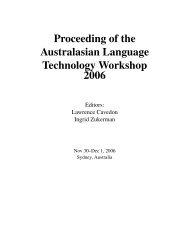The MBC information booklet - RMIT University
The MBC information booklet - RMIT University
The MBC information booklet - RMIT University
You also want an ePaper? Increase the reach of your titles
YUMPU automatically turns print PDFs into web optimized ePapers that Google loves.
9.1.6 ISYS1088—<br />
Systems<br />
Architecture<br />
9.1.7 COSC1182—<br />
Usability<br />
Engineering<br />
Chapter 9: Software Engineering<br />
Typical test tools will be discussed. In particular we will learn how to apply many of the<br />
tools that come with IBM's Rational Suite TestStudio product in order to gain a solid<br />
understanding of how testing is done in practice.<br />
Pre-requisite Courses and Assumed Knowledge and Capabilities<br />
• A knowledge of basic high school/first level math including algebra, binary<br />
arithmetic, boolean logic, and elementary statistics<br />
• 6 months’ programming experience in any high level computer language<br />
For more <strong>information</strong> on the course, go to www.rmit.edu.au/courses2006/004186.<br />
Note: This is a Masters-level course.<br />
Course Description<br />
As the Software Engineering Institute (SEI) states: “For all but the most trivial system,<br />
success will be elusive if you fail to pay careful attention to its architecture: the way the<br />
system is decomposed into constituent parts and the ways those parts interact.” <strong>The</strong><br />
primary aims of this course are to provide you with a sound understanding of architecture<br />
concepts, functions, tasks and techniques, and to expose you to the practical aspects of<br />
architecture through the analysis of case studies and design assignments. It also aims<br />
to enable you to understand what is required at a high level to evaluate, communicate<br />
and document architectures.<br />
Pre-requisite Courses and Assumed Knowledge and Capabilities<br />
• You will be expected to understand key processes, knowledge and capabilities<br />
equivalent to those acquired in ISYS1117 Software Engineering Analysis and<br />
Design and COSC1321 Computing Fundamentals.<br />
For more <strong>information</strong> on the course, go to www.rmit.edu.au/courses2006/004187.<br />
Note: This is a Masters-level course.<br />
Course Description<br />
Usability is the extent to which a product can be used by specified users to achieve<br />
specified goals with effectiveness, efficiency and satisfaction in a specified context of<br />
use (ISO 9241-11 1998). Usability engineering is a set of behavioural research methods<br />
and techniques that can be applied at every stage of the software development lifecycle,<br />
to improve the usability of the developed product by conducting usability studies that<br />
analyse users’ needs or evaluate the product’s usability.<br />
This course introduces you to concepts, methods and techniques that you can apply to<br />
design and conduct usability studies, building on your practical experience with software<br />
system analysis and design, and with writing and testing code. You will learn the theory<br />
and practice of various approaches, methods and techniques, and apply these to<br />
acquire practical experience in conducting usability studies for interactive systems.<br />
Tutorial activities provide the skills you need to complete the major assignment, where<br />
you design a usability test of an interactive system, recruit suitable participants, conduct<br />
the test, and analyse and report on your findings.<br />
Pre-requisite Courses and Assumed Knowledge and Capabilities<br />
• Practical experience with software system analysis and design, equivalent to<br />
ISYS1117 Software Engineering Analysis and Design<br />
• Practical experience with writing and testing code, equivalent to COSC1321<br />
Computing Fundamentals<br />
For more <strong>information</strong> on the course, go to www.rmit.edu.au/courses2006/004199.<br />
41
















